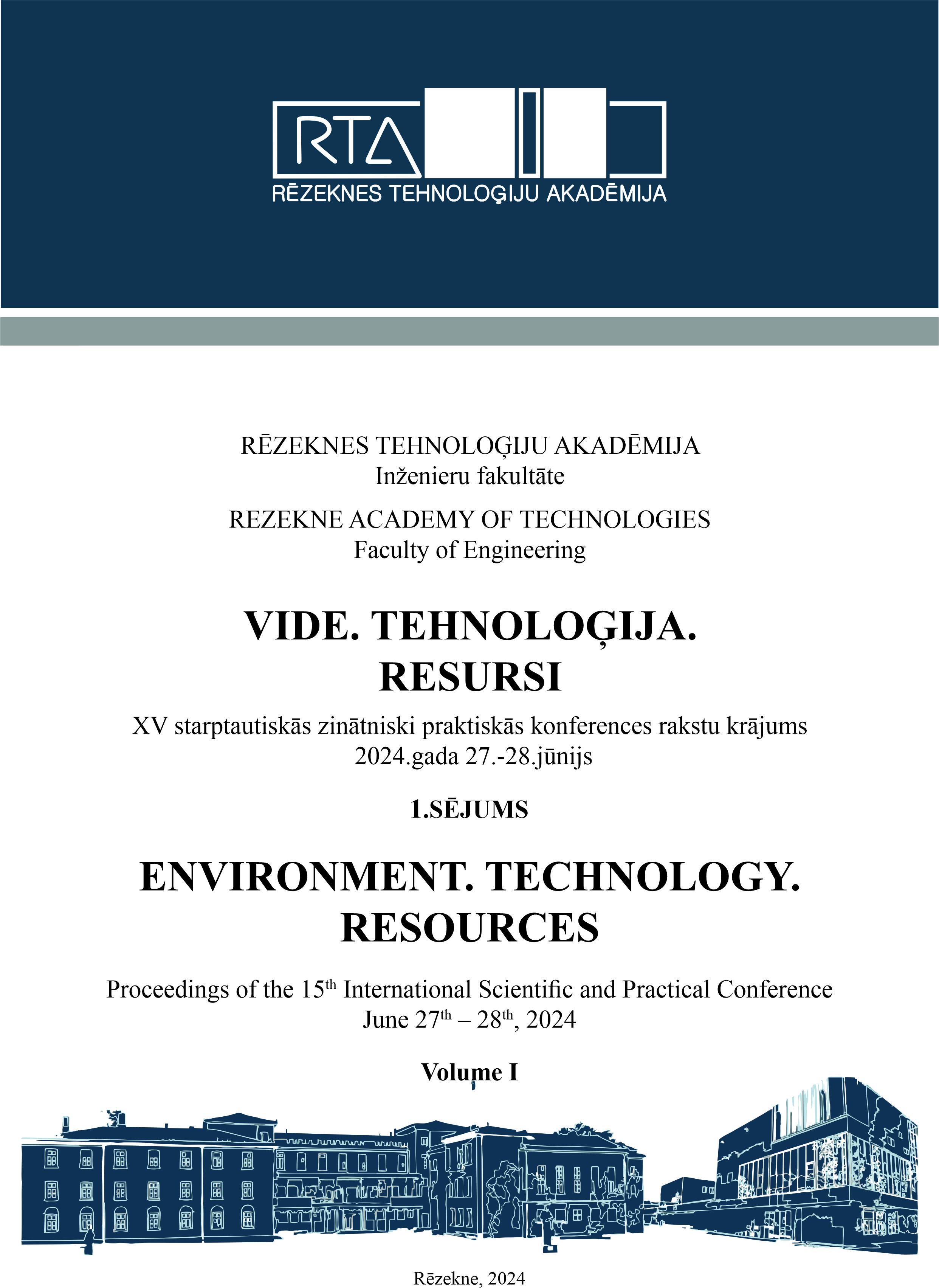ARONIA MELANOCARPA (BLACK CHOKEBERRY) BRANCHES BIOMASS AS A SOURCE OF VALUABLE BIOLOGICALLY ACTIVE COMPOUNDS WITH ANTIOXIDANT AND ANTIMICROBIAL POTENTIAL
DOI:
https://doi.org/10.17770/etr2024vol1.7981Keywords:
Aronia melanocarpa, Black Chokeberry, polyphenols, antimicrobial activityAbstract
Aronia melanocarpa is a hardy berry-producing shrub that demands low maintenance and can grow on almost any type of soil. Since the best fruits can be obtained on the branches younger than 7 years, pruning of 1/3 of the shrub is usually performed each winter or after flowering, and also to remove damaged or overgrown branches. For sustainable production of Aronia melanocarpa berries, it is necessary to find a rational use for this pruning lignocellulosic biomass. Some studies available for Aronia melanocarpa berries show that they are very rich in various biologically active substances with proven functional and pharmacological activities including anti-inflammatory, antioxidant, and antimicrobial properties. The chemical composition of Aronia melanocarpa branches is currently almost unknown. The study aimed to evaluate the composition and potential of chokeberry branches as a source of polyphenols. General chemical characterization of the biomass was carried out using the method of analytical pyrolysis. Extraction of branch biomass was carried out using aqueous alcohol solutions. Quantitative analysis of the extracts showed a large amount of oligomeric proanthocyanidins. The most suitable extractant was determined to obtain the highest yield of the dominant polyphenols in the hydrophilic extract. The antioxidant activity of the hydrophilic extracts as well as antibacterial activity against six pathogenic bacteria was evaluated. The results showed the high potential of chokeberry lignocellulosic biomass as a source of valuable biologically active compounds for the creation of preparations for the healthcare, nutrition industry, and cosmetics.
References
T. Jurendić and M. Ščetar, “Aronia melanocarpa Products and By-Products for Health and Nutrition: A Review,” Antioxidants, vol. 10, no. 7, p. 1052, Jun. 2021, doi: 10.3390/antiox10071052.
S. Kulling and H. Rawel, “Chokeberry (Aronia melanocarpa) – A Review on the Characteristic Components and Potential Health Effects,” Planta Med, vol. 74, no. 13, pp. 1625–1634, Oct. 2008, doi: 10.1055/s-0028-1088306.
“University of Minnesota Extension, Yward and Garden, Black chokeberry.” Accessed: Feb. 17, 2024. [Online]. Available: https://extension.umn.edu/trees-and-shrubs/black-chokeberry
A. Kokotkiewicz, Z. Jaremicz, and M. Luczkiewicz, “Aronia Plants: A Review of Traditional Use, Biological Activities, and Perspectives for Modern Medicine,” Journal of Medicinal Food, vol. 13, no. 2, pp. 255–269, Apr. 2010, doi: 10.1089/jmf.2009.0062.
M. C. Roda-Serrat, B. Razi Parjikolaei, M. Mohammadifakhr, J. Martin, B. Norddahl, and M. Errico, “A Case Study for the Extraction, Purification, and Co-Pigmentation of Anthocyanins from Aronia melanocarpa Juice Pomace,” Foods, vol. 11, no. 23, p. 3875, Dec. 2022, doi: 10.3390/foods11233875.
“Platibas-aug-lielakie-smiltserksku-aroniju-un-cidoniju-lauki.” Accessed: Feb. 18, 2024. [Online]. Available: https://lasi.lv/saimnieks-uznemejs/darzkopiba/platibas-aug-lielakie-smiltserksku-aroniju-un-cidoniju-lauki.4417
“Majrazotaju-nisa-aronijas-ogu-vertiba-un-parstrades-iespejas.” Accessed: Feb. 18, 2024. [Online]. Available: https://lasi.lv/saimnieks-uznemejs/bizness/majrazotaju-nisa-aronijas-ogu-vertiba-un-parstrades-iespejas.3847
“Technavio.com.” Accessed: Feb. 22, 2024. [Online]. Available: https://www.technavio.com/report/aronia-berries-market-size-industry-analysis
M. Bräunlich, R. Slimestad, H. Wangensteen, C. Brede, K. Malterud, and H. Barsett, “Extracts, Anthocyanins and Procyanidins from Aronia melanocarpa as Radical Scavengers and Enzyme Inhibitors,” Nutrients, vol. 5, no. 3, pp. 663–678, Mar. 2013, doi: 10.3390/nu5030663.
S. Skirvin, Robert. Robert., “Black chokeberry (Aroma melanocarpa Michx.): A semi-edible fruit with no pests. .,” Journal of the American Pomological Society, vol. 61, pp. 135–137, 2007.
A. Nawirska and M. Kwaśniewska, “Dietary fibre fractions from fruit and vegetable processing waste,” Food Chemistry, vol. 91, no. 2, pp. 221–225, Jun. 2005, doi: 10.1016/j.foodchem.2003.10.005.
M. Banach, M. Wiloch, K. Zawada, W. Cyplik, and W. Kujawski, “Evaluation of Antioxidant and Anti-Inflammatory Activity of Anthocyanin-Rich Water-Soluble Aronia Dry Extracts,” Molecules, vol. 25, no. 18, p. 4055, Sep. 2020, doi: 10.3390/molecules25184055.
D. Zapolska-Downar, D. Bryk, M. Małecki, K. Hajdukiewicz, and D. Sitkiewicz, “Aronia melanocarpa fruit extract exhibits anti-inflammatory activity in human aortic endothelial cells,” Eur J Nutr, vol. 51, no. 5, pp. 563–572, Aug. 2012, doi: 10.1007/s00394-011-0240-1.
C. B. Christiansen, P. B. Jeppesen, K. Hermansen, and S. Gregersen, “Aronia in the Type 2 Diabetes Treatment Regimen,” Nutrients, vol. 15, no. 19, p. 4188, Sep. 2023, doi: 10.3390/nu15194188.
I. Banjari et al., “Antidiabetic Effects of Aronia melanocarpa and Its Other Therapeutic Properties,” Front. Nutr., vol. 4, p. 53, Nov. 2017, doi: 10.3389/fnut.2017.00053.
A. Szopa et al., “Comparative analysis of different groups of phenolic compounds in fruit and leaf extracts of Aronia sp.: A. melanocarpa, A. arbutifolia, and A. ×prunifolia and their antioxidant activities,” Eur Food Res Technol, vol. 243, no. 9, pp. 1645–1657, Sep. 2017, doi: 10.1007/s00217-017-2872-8.
N. Thi and E.-S. Hwang, “Anti-cancer and anti-inflammatory activities of aronia (Aronia melanocarpa) leaves,” Asian Pac J Trop Biomed, vol. 8, no. 12, p. 586, 2018, doi: 10.4103/2221-1691.248095.
A. Andersone et al., “A comparative analysis of the proanthocyanidins from fruit and non-fruit trees and shrubs of Northern Europe: Chemical characteristics and biological activity,” Sustainable Chemistry and Pharmacy, vol. 36, p. 101266, Dec. 2023, doi: 10.1016/j.scp.2023.101266.
C. J. L. Murray et al., “Global burden of bacterial antimicrobial resistance in 2019: a systematic analysis,” The Lancet, vol. 399, no. 10325, pp. 629–655, Feb. 2022, doi: 10.1016/S0140-6736(21)02724-0.
A. Andersone et al., “Granulated Animal Feed and Fuel Based on Sea Buckthorn Agro-Waste Biomass for Sustainable Berry Production,” Sustainability, vol. 15, no. 14, p. 11152, Jul. 2023, doi: 10.3390/su151411152.
A. Andersone et al., “Anti-Inflammatory, Anti-Bacterial, and Anti-Fungal Activity of Oligomeric Proanthocyanidins and Extracts Obtained from Lignocellulosic Agricultural Waste,” Molecules, vol. 28, no. 2, p. 863, Jan. 2023, doi: 10.3390/molecules28020863.
T. Dizhbite, G. Telysheva, V. Jurkjane, and U. Viesturs, “Characterization of the radical scavenging activity of lignins - natural antioxidants,” Bioresource Technology, vol. 95, no. 3, pp. 309–317, Dec. 2004, doi: 10.1016/j.biortech.2004.02.024.
F. Nie et al., “Oligomeric Proanthocyanidins: An Updated Review of Their Natural Sources, Synthesis, and Potentials,” Antioxidants, vol. 12, no. 5, p. 1004, Apr. 2023, doi: 10.3390/antiox12051004.
S. Toden, P. Ravindranathan, J. Gu, J. Cardenas, M. Yuchang, and A. Goel, “Oligomeric proanthocyanidins (OPCs) target cancer stem-like cells and suppress tumor organoid formation in colorectal cancer,” Sci Rep, vol. 8, no. 1, p. 3335, Feb. 2018, doi: 10.1038/s41598-018-21478-8.
Downloads
Published
Issue
Section
License
Copyright (c) 2024 Anna Andersone, Sarmite Janceva, Natalija Zaharova, Vizma Nikolajeva, Vilhelmine Jurkjane

This work is licensed under a Creative Commons Attribution 4.0 International License.



